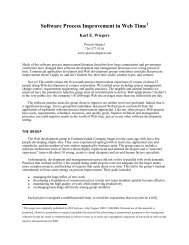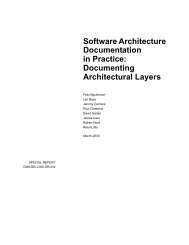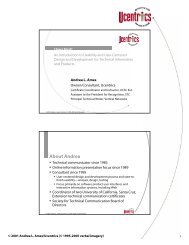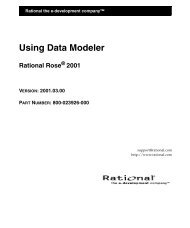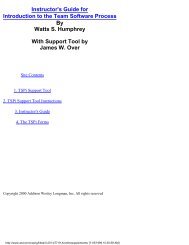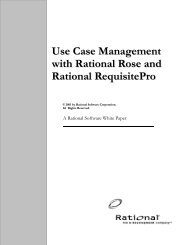RSI - A Structured Approach Use Cases and HCI Design
RSI - A Structured Approach Use Cases and HCI Design
RSI - A Structured Approach Use Cases and HCI Design
You also want an ePaper? Increase the reach of your titles
YUMPU automatically turns print PDFs into web optimized ePapers that Google loves.
The <strong>RSI</strong> <strong>Approach</strong> To <strong>HCI</strong> <strong>Design</strong> / <strong>Use</strong> Case Analysis Page 11 of 42<br />
…<br />
5) The system now displays these costs to the user using the cost display form. The<br />
total cost <strong>and</strong> the required user's contribution are both shown.<br />
6) The system creates an invoice <strong>and</strong> adds this to the user's account.<br />
7) The user elects to pay the balance using the 'pay now' button.<br />
…<br />
One concern regarding such descriptions is that the implicit user interface navigation<br />
may not be appropriate when user interface design is considered in more detail.<br />
• different levels of granularity of use case were used. These varied from the 'business<br />
process' level - as described by Cockburn (see above) <strong>and</strong> as described by Jacobson et<br />
al. in Software Reuse [8] (page 220):<br />
A business use case is a sequence of work steps performed in a business system that<br />
produces a result of perceived <strong>and</strong> measurable value to an individual actor of the<br />
business.<br />
- to the 'system interaction' level - e.g. the use of actions (the Catalysis equivalent of<br />
use cases) in Wills <strong>and</strong> DeSouza's Catalysis [10] (see example below), <strong>and</strong> ''define a<br />
style'', ''change a style'' as described in Fowler's UML Distilled [9] (see page 44 in which<br />
Fowler discusses the difference between user goals <strong>and</strong> system interactions).<br />
• some use case descriptions were accompanied by a type or class diagram, as best<br />
exemplified throughout Wills <strong>and</strong> DeSouza's Catalysis. We found these greatly<br />
increased the clarity of use cases when considered from a system designers perspective;<br />
• Cockburn's guidelines [2] for use cases at the 'business process' level were the most<br />
consistently applied, as exemplified by the following example from Pete McBreen of<br />
McBreen Consulting in Canada (petemcbreen@acm.org).<br />
Driver : Enter Parkade (Car Park) with Ticket<br />
Driver requests entrance to parkade, receives ticket <strong>and</strong> then enters parking lot.<br />
Success End Condition<br />
Driver is allowed entrance to Lot.<br />
A Ticket is issued that records the date/time of entrance.<br />
The available spaces in the parkade are decremented by 1 (Available Spaces >= 0 )<br />
Lot Full signs illuminated if Available Spaces == 0<br />
Failure End Condition<br />
Driver is not allowed entrance to Parkade.<br />
W5a - <strong>RSI</strong> LONG PAPER [42 PAGES].doc( Rev: 5) - 03/09/00



